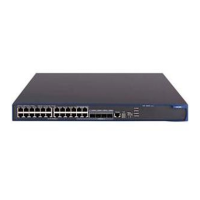1-3
Table 1-1 describes how the ports on various switches are involved in the mirroring
operation.
Table 1-1 Ports involved in the mirroring operation
Switch Ports involved Function
Source port
Port monitored. It copies packets to
the reflector port through local port
mirroring. There can be more than one
source port.
Reflector port
Receives packets from the source port
and broadcasts the packets in the
remote-probe VLAN.
Source switch
Trunk port
Sends mirrored packets to the
intermediate switch or the destination
switch.
Intermediate switch
Trunk port
Sends mirrored packets to the
destination switch.
Two trunk ports are necessary for the
intermediate switch to connect the
devices at the source switch side and
the destination switch side.
Trunk port
Receives remote mirrored packets.
Destination switch
Destination port
Receives packets forwarded from the
trunk port and transmits the packets to
the data detection device.
z Do not configure a default VLAN, a management VLAN, or a dynamic VLAN as the
remote-probe VLAN.
z Configure all ports connecting the devices in the remote-probe VLAN as trunk ports,
and ensure the Layer 2 connectivity from the source switch to the destination switch
over the remote-probe VLAN.
z Do not configure a Layer 3 interface for the remote-probe VLAN, run other protocol
packets, or carry other service packets on the remote-prove VLAN and do not use the
remote-prove VLAN as the voice VLAN and protocol VLAN; otherwise, remote port
mirroring may be affected.
MAC-Based Mirroring
With MAC-based mirroring configured, a device mirrors packets matching the specified
MAC address to the destination port, including:
z Packets with the source MAC address matching the specified MAC address.

